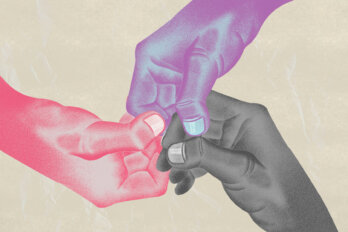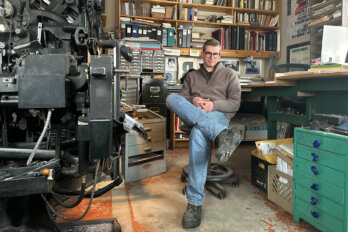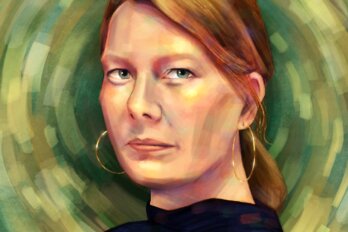When I was eight years old and in Brownies, a fat girl broke our sacred plaster toadstool. The toadstool is, as many former Sprites, Elves and Pixies can attest, important to the various rites and rituals of Browniedom. It’s hopped over, danced around and, on occasion, sat on—because, truly, what child wouldn’t want to sit on a toadstool?
The next time our unit met, we sat in a circle and watched as the toadstool-breaker carried out her punitive performance: alone and in tears, she had to pour out a new plaster toadstool in front of us. We were not allowed to help her, because she was atoning for her poor judgement. She was also atoning for her fatness. All other Brownies understood the cautionary shame and sadness as we watched her try not to spill wet plaster on the gymnasium floor. Be fat and this will happen to you, too.
This fat little Brownie from my childhood had what the writer and professor Roxane Gay so aptly calls an “unruly body”—a body that does not behave in the way society expects or wants it to behave. She has expressed this perspective before. In her 2014 essay collection, Bad Feminist, Gay discussed the ways that feminism can be messy and called up parts of her life that flout feminism’s purported rules—playing dumb around men, busting out moves to music with misogynistic lyrics. Her newest book, Hunger: A Memoir of (My) Body, likewise traverses what it means to not fit into another set of parameters: the tangible dimensions of the corporeal world.
In Hunger, Gay tells us what it is like to occupy her own unruly body—one that neither conforms to, nor is accommodated by, others. She details brutal sexual violence in her childhood that made her want to seek refuge in her own form. She takes us with her into young adulthood, when she tenuously finds ways to connect with other people, carefully and cautiously. And, throughout the book, she talks about her hunger. It’s literal: the hunger to feed and nourish her body. It’s also a hunger to change, to be loved and to love; the hunger of desire, the hunger to be relieved of pain, and the hunger to be seen.
Gay, who is forty-two and has been called upon to bear the nastily-named categorization of “super-morbidly obese”, makes her experiences plain, from day-to-day concerns like ensuring places she visits will have sturdy chairs and the agony of booking flights and air travel, to the way doctors treat her and death threats routinely directed at her over social media. As she exposes her pain and hunger, she lays her body bare and shows us how it is to be a person of size in a world that hates fatness. Gay however never resigns to absolute vulnerability, and in this book she has absolute power, in control of her story and concealing and exposing information in a dance.
For so many people, becoming fat symbolizes personal disaster. It represents a loss of control, a failure of will, and a worst-case scenario. This fear of fat and fatness is hardly ill-founded phobia: the alarmist language around the “obesity epidemic”, nutrition fads, and the manifest status that emerges from keenly disciplined eating have very real consequences on who you are in the world and how you are treated. People are deeply invested in understanding how not to be fat and attributing value to the corresponding habits of the lean-bodied. In Ontario, where I live, the Healthy Menu Choices Act, instated in 2015, requires restaurants and fast food locations to list caloric information for each item being offered—but not to present a breakdown of complete nutritional information. That sends a message that the number of calories is what counts for health, reinforcing at the legislative level that fat is uniformly bad. So then, who would ever really want to be fat?
From childhood, we understand what fatness entails: it means to be undesirable, the chummy sidekick, subject to fluctuations of size and status; to be greedy, a joke. Almost all children’s movies have a fat character who is silly, loves to eat, and who may be sweet but is probably also a little stupid, or else who is wicked in their gluttony. From Dudley the Muggle to Chief Wiggum, Ursula the Sea Witch to Honey Boo Boo, the tropes range from dim-witted and cruel to vacant, and from conniving and manipulative to lovable—but subject to our pity. This summer’s blockbuster has it, too: Ned, Peter Parker’s best friend in Spider-Man: Homecoming, is adorable, intelligent, loyal, and lovable—but we understand that he will never be the hero. It’s not a fat kid’s place.
I am not a fat person. However, I am not a thin person, either. There are times when I “pass”, and I can reliably find clothes that fit me that I like without having to look for special sizes. People react to me almost uniformly with effervescent joy if they believe I have lost weight. In the company of non-fat people, especially non-fat women, I am usually the most fat. I am closest to the border; I am on the edge. This tends to instil a slightly heightened sense of awareness in everyone about me and my body, and how I fit in there. If I am one of them, what does it say about their bodies? Am I the biggest one in the room—the one who is not like the others—or are some of them more like me?
Fatness is a spectrum, which is why we turn on our own, even out-fatting each other. It’s a subtle response, but it is there. I hear it when women slimmer than me talk about being naughty for what they have eaten. “I’m being so bad this week,” one will say, popping a Timbit into her mouth. “I’m going to gain so much weight.” The dangling consequence, on the tip of my tongue is, “And then you will look like me?”. Because that is what the woman is saying, without meaning to say it to me. If her bad behaviour continues, she might—horror of horrors—end up with a body that resembles mine. “I’m so not bikini ready,” is another statement shared among women in that “bonding,” confessional way. Imagine, then, for the speaker, what the idea of me in a bikini represents? If she looked like me, it would be a nightmare.
In such moments, I have to resist portraying the “good” kind of bigger woman. By which, I mean the one who is displaying her efforts to change her body and to be healthy (here, “healthy” is code for slim). The good kind of bigger woman has her body under control; she may have generous hips, thighs and breasts, but a small waist; she is a strong, strapping, and hearty example of what your grandfather would have wanted in a woman. If I am following the same diet-and-exercise practices thinner people follow, yielding a result they would be disappointed in displaying themselves, I must somehow be doing something else wrong. I try not to fall into familiar stereotypes when I am with slim people who show their fear of fat, but it is hard. Their discomfort is exhausting. Sometimes I let myself be their milk-fed, big-boned girl. As long as I don’t break the toadstool, I am considered OK.
I am white, middle-class, employed, heterosexual, in good mental health, and surrounded by a community of like-minded friends. It’s far easier for me to live in my body than it is for anyone without these and other identifications. My experience is nowhere near as difficult as Gay’s is. And for people fatter than me, I represent the thin woman. But fatness has been a defining part of my experience. I was born not-small, the biggest member of a family of trim people. I have memories of adults commenting on my size from early on, and of many peripheral figures such as teachers, swimming coaches, babysitters and other parents trying to manage my intake of food. When I was in grade seven, a friend’s mother coined the nickname “Moose” for me (I was also tall), and while she admitted to being sloshed and in the next breath was singing along to “Janie’s Got A Gun,” I had to fight to stay cheerful and refuse the spaghetti dinner she gave us to save face.
Later, when I saw people after a semester or whole grade had passed, and I looked slimmer (less moose-like), I received more enthusiastic celebration than for a whole youth of academic accolades combined. It was a clear message and I received it everywhere I went. Everywhere I looked for examples of a different set of requirements for what “good” was, I was met with a very similar set of ideals. Trying to tame my own unruly body, and keep it that good, smaller way almost killed me over many years. Now, I am aware of how lucky I am to be in good health, though like many people, I constantly negotiate how my body fits in, and whether it will fit, period. I can’t tell what the right amount to eat is, sometimes. I have many hungers, too.
All of Gay’s work has received some criticism, as is to be expected for any serious author who is suddenly the subject of wide adoration and acclaim. I was talking to a friend about backlash we had heard about Hunger and she pointed out that no ever minded anything Gay had said so much as when she started talking about being fat. I think this distaste may have something to do with people needing to believe that fatness is due to laziness, to bad choices, or to lack of education. They need to believe that they would never be in the position that Gay is in because they know better; they are better. What is so breathtaking about Hunger is that it shows the way Gay’s body has become large, more unruly—and that the reasons for it are complex and difficult. Horrific, traumatic life events are commonplace and shockingly democratic. Yes, everyone should enjoy and be proud of their bodies, but no one person has a body that is superior to another. This is an idea that is counter-intuitive to basically everything dominant culture tells us, all the time. And so it follows that a book that illustrates this point with humanity, humour, and grace, may be a problem for some.
I started reading Hunger and, ravenous, finished it in a day. If you are someone who is fat, who knows someone who is fat, who has ever felt annoyed by someone’s big body being in your way; ever privately judged the contents of a fat person’s grocery cart, or thought you should mention someone’s weight to them; if you have had your weight mentioned to you, if someone has tried to manage your body; if you have experienced trauma and tried to protect yourself afterward, and escape; if you are scared of being fat, and of gaining weight, if you are scared to eat or feel you are judged for eating, if you are a person, as I am a person; please, read this book.





